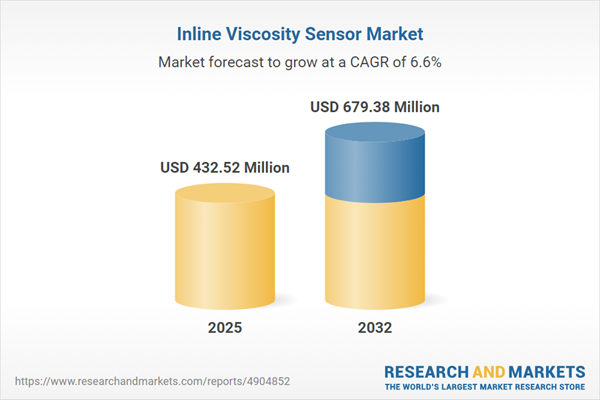Speak directly to the analyst to clarify any post sales queries you may have.
Senior decision-makers are prioritizing digital transformation across manufacturing and process industries, positioning the inline viscosity sensor market as vital for achieving enhanced operational agility, real-time production insights, and regulatory alignment in rapidly changing global environments.
Market Snapshot: Inline Viscosity Sensor Market Size and Growth
In 2024, the inline viscosity sensor market reached USD 405.99 million and is projected to grow to USD 432.52 million by 2025, achieving nearly USD 679.38 million by 2032. This represents a compound annual growth rate of 6.64%. The expansion is attributed to increased digital integration, the need for streamlined production, and broad cross-industry applicability. The chemical, oil and gas, pharmaceutical, and food and beverage sectors are leading adoption, emphasizing efficiency, transparency, and compliance. As demand intensifies, organizations are evolving supplier and procurement approaches, using inline viscosity sensors to enhance data-driven quality management and resilience under changing supply chain conditions.
Scope & Segmentation
This report provides actionable insights tailored for executive teams to support strategic decision-making on technology investments and market positioning. Analysis clarifies adoption patterns and operational alignment for executive priorities across key areas:
- Product Types: Microfluidic sensors, rotational devices, ultrasound-based instruments, and vibrational systems, enabling advanced process monitoring and immediate analytics.
- Technologies: Capacitive, Coriolis, laser Doppler, torsional resonance, and vibrating rod instruments, supporting precision viscosity measurement in diverse industrial conditions.
- Flow Types: Solutions for single-phase and multi-phase process streams, offering necessary flexibility for processing complex mixtures, fluids, and gases.
- End-Use Industries: Chemicals, oil and gas, pharmaceuticals, food and beverage, paints, and coatings, where optimized performance, yield, and regulatory compliance are essential.
- Applications: Real-time process monitoring, quality control, endpoint analysis, and plant optimization, supporting production reliability and research functions.
- Regions Covered: Americas, Europe, Middle East & Africa, and Asia-Pacific, with each region exhibiting distinctive adoption patterns and technology maturity.
- Key Companies: Emerson Electric Co., Endress+Hauser AG, Siemens AG, Anton Paar GmbH, Mettler-Toledo International Inc., KROHNE Messtechnik GmbH, Yokogawa Electric Corporation, JASCO Corporation, Promix, Hydramotion Ltd., and AMETEK Inc. are shaping industry standards and driving technological innovation.
In-depth segmentation ensures executive teams can align selection of sensor systems with business objectives and future compliance requirements, strengthening readiness for operational shifts and regulatory demands.
Key Takeaways for Senior Decision Makers
- Inline viscosity sensors deliver real-time analytics, enabling prompt, data-driven responses to production changes.
- Establishing standardized sensor protocols promotes consistent quality controls, aligning global benchmarks and improving compliance management.
- Advanced technologies offer adaptability to evolving industry regulations and production standards, ensuring long-term operational resilience.
- Integrated sensor networks enable predictive maintenance and continuous diagnostics, reducing downtime risk and maximizing asset efficiency.
- Partnering with major sensor vendors allows for industry-aligned solutions and efficient compliance navigation.
- In-built analytics support robust documentation and audit readiness, easing regulatory reporting requirements for highly regulated sectors.
Tariff Impact: United States Supply Chain Dynamics
Recent U.S. tariff changes highlight the need for flexible sourcing and supplier management strategies. Modular inline viscosity sensor designs help manufacturers diversify supply chains, ensuring operational resilience and responsiveness to evolving trade regulations and market conditions.
Methodology & Data Sources
The analysis combines executive interviews with input from industry panels and comprehensive secondary research. Proprietary analytics and deployment data confirm findings, aligning with established industry standards and best practices for market assessment.
Primary Keyword Spotlight: Inline Viscosity Sensor Market
The inline viscosity sensor market is advancing as manufacturers accelerate integration of machine learning and predictive analytics for smarter process control. European markets emphasize compliance and plant safety, while North American organizations focus on digital innovation and process intelligence. In Asia-Pacific, the trajectory centers on large-scale automation and rapid plant modernization. Navigating these regional distinctions supports targeted technology deployment and competitive market positioning.
Why This Report Matters
- Guides executives in making sensor investments that strengthen traceability, adaptive resource allocation, and operational flexibility for digital transformation.
- Provides segmented analysis and planning support, aiding organizations to manage complex investment and regulatory mandates across multinational operations.
- Delivers benchmarking resources to maintain operational continuity as compliance expectations and technologies advance.
Conclusion
This report equips executive teams to harmonize sensor technology strategies with evolving regulation, fostering improved performance, reliability, and quality across industrial operations.
Additional Product Information:
- Purchase of this report includes 1 year online access with quarterly updates.
- This report can be updated on request. Please contact our Customer Experience team using the Ask a Question widget on our website.
Table of Contents
3. Executive Summary
4. Market Overview
7. Cumulative Impact of Artificial Intelligence 2025
Companies Mentioned
The companies profiled in this Inline Viscosity Sensor market report include:- Emerson Electric Co.
- Endress+Hauser AG
- Siemens AG
- Anton Paar GmbH
- Mettler-Toledo International Inc.
- KROHNE Messtechnik GmbH
- Yokogawa Electric Corporation
- JASCO Corporation
- Promix
- Hydramotion Ltd.
- AMETEK.Inc.
Table Information
| Report Attribute | Details |
|---|---|
| No. of Pages | 199 |
| Published | November 2025 |
| Forecast Period | 2025 - 2032 |
| Estimated Market Value ( USD | $ 432.52 Million |
| Forecasted Market Value ( USD | $ 679.38 Million |
| Compound Annual Growth Rate | 6.6% |
| Regions Covered | Global |
| No. of Companies Mentioned | 12 |









